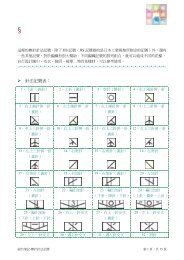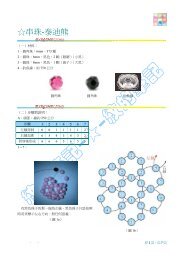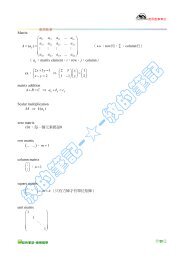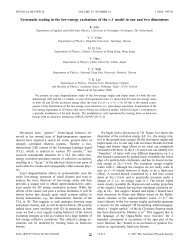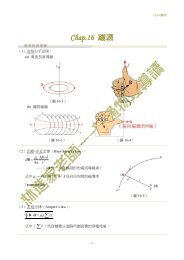π ω = π θ π θ ω π θ π θ ω - 物理學系- 東海大學
π ω = π θ π θ ω π θ π θ ω - 物理學系- 東海大學
π ω = π θ π θ ω π θ π θ ω - 物理學系- 東海大學
Create successful ePaper yourself
Turn your PDF publications into a flip-book with our unique Google optimized e-Paper software.
Fundamentals of Physics<br />
Halliday & Resnic<br />
【CH10】Rotational Motion I<br />
Homework of Chapter 10:<br />
3, 5, 7, 9, 13, 17, 21, 25, 27, 31, 33, 35, 37, 39, 43, 47, 49, 51, 55, 59, 63, 66<br />
<strong>東海大學</strong>物理系<br />
【Problem 10-3】<br />
A diver makes 2.5 revolutions on the way from a 10m high platform to the water. Assuming zero<br />
initial vertical velocity, find the average angular velocity during the dive.<br />
一個人從 10m 高的跳水台跳到水裡,過程中轉了 2.5 圈。假設初始垂直速度為零,問跳水<br />
過程中平均角速度為何?<br />
1<br />
Δ y = v t+ gt<br />
2<br />
: 0 y<br />
= 0<br />
⇒<br />
2<br />
2Δy2(10) t = = = 1.4s<br />
g 9.8<br />
(2.5 rev)(2 <strong>π</strong> rad / rev)<br />
<strong>ω</strong> avg = = 11 rad / s<br />
1.4s<br />
【Problem 10-5】<br />
When a slice of buttered toast is accidentally pushed over the edge of a counter, it rotates as it falls.<br />
If the distance to the floor is 76 cm and for rotation less than 1 rev, what are the (a) smallest and (b)<br />
largest angular speeds that cause the toast to hit and then topple to be butter-side down?<br />
一片烤奶油麵包,意外的被推向櫃臺邊緣,當它掉下來時,同時旋轉。如果距離地面 76cm,<br />
轉速小於 1rev(意思是土司旋轉不會超過 1 圈),問撞到奶油端時(土司另一端撞到地面),<br />
何為(a)最小和(b)的最大的角速度?<br />
1<br />
: h= gt<br />
2<br />
2<br />
2h2(0.76 m)<br />
Δ t = = = 0.394 s.<br />
2<br />
g 9.8 m/s<br />
(a) 土司旋轉然後掉到地面時的最小角度為<br />
<strong>π</strong><br />
Δ <strong>θ</strong>min<br />
= 0.25 rev = rad<br />
2<br />
<br />
Fundamentals of Physics<br />
Halliday & Resnic<br />
(掉到地面土司旋轉不超過一圈,且 A 端掉下,旋轉後 B 端撞到地面)<br />
<strong>π</strong><br />
rad<br />
Δ<strong>θ</strong>min<br />
<strong>ω</strong><br />
2<br />
min = = = 4.0 rad/s<br />
Δt<br />
0.394 s<br />
3<strong>π</strong><br />
Δ <strong>θ</strong> = 0.75 rev = rad<br />
2<br />
(b) max<br />
(掉到地面土司旋轉不超過一圈,且 A 端掉下,旋轉後 D 端撞到地面)<br />
3<strong>π</strong> rad<br />
Δ<strong>θ</strong>max<br />
<strong>ω</strong><br />
2<br />
max = = = 12.0 rad/s<br />
Δt<br />
0.394 s<br />
<strong>東海大學</strong>物理系<br />
【Problem 10-7】<br />
The wheel in Fig. 10-30 has eight equally spaced spokes and a radius of 30 cm. It is mounted on a<br />
fixed axle and is spinning at 2.5 rev/s. You want to shoot a 20cm long arrow parallel to this axle and<br />
through the wheel without hitting any of the spokes. Assume that the arrow and the spokes are very<br />
thin. (a) What minimum speed must the arrow have? (b) Does it matter where between the axle and<br />
rim of the wheel you aim? If so, what is the best location?<br />
(圖 10-30)<br />
圖 10-30,一車輪有 8 個等距離的輪輻,其半徑 30cm。它是安裝在固定的軸上旋轉,2.5 轉<br />
/秒。你想射出一個 20cm 長的箭,使其通過這種車輪而沒有擊中任何的輪輻。假設箭頭和<br />
輪輻都非常薄。(a)箭的最低速度為多少?(b)你的目標是否是在哪一處車軸間的輪輻?<br />
如果有的話,何為最好的位置?<br />
1<br />
rev<br />
:(a) 為了避免箭碰到車輪的輪輻,箭經過車輪的時間必須不超過 Δ t = 8 = 0.05s<br />
2.5 rev / s<br />
20cm<br />
所以,箭的最小速度為 vmin = = 400 cm/ s= 4 m/ s<br />
0.05s
Fundamentals of Physics<br />
Halliday & Resnic<br />
(b) No—there is no dependence on radial position in the above computation.<br />
<strong>東海大學</strong>物理系<br />
【Problem 10-9】<br />
A disk, initially rotating at 120 rad / s , is slowed down with a constant angular acceleration of<br />
2<br />
magnitude 4 rad / s . (a) How much time does the disk take to stop? (b) Through what angle does<br />
the disk rotate during that time?<br />
2<br />
一圓盤,一開始轉動速率120 rad / s ,緩慢地以角加速度 4 rad / s 減少轉速。(a)圓盤停止<br />
時花了多少時間?(b)在那段時間,圓盤轉了多少角度?<br />
:(a) <strong>ω</strong> = <strong>ω</strong>0+ αt<br />
<strong>ω</strong> −<strong>ω</strong>0 0−120 ⇒ t = = = 30s<br />
α ( −4)<br />
1 1<br />
3<br />
(b) <strong>θ</strong> = ( <strong>ω</strong>+ <strong>ω</strong>0)<br />
t = (120 + 0)(30) = 1.8× 10 rad<br />
2 2<br />
【Problem 10-13】<br />
2<br />
A wheel has a constant angular acceleration of 3 rad / s . During a certain 4.0 s interval, it turns<br />
through an angle of 120 rad. Assuming that the wheel started from rest, how long has it been in<br />
motion at the start of this 4.0 s interval?<br />
2<br />
一輪子具有固定角加速度 3 rad / s 。在某一個 4秒期間,它轉了 120rad。假設輪子一開始<br />
是靜止狀態,問在這個 4秒期間之前,它運動了多久?<br />
1<br />
: <strong>θ</strong> = <strong>ω</strong>0t+ αt<br />
2<br />
2<br />
1 2 1 2<br />
<strong>θ</strong> − αt120<br />
− (3)(4 )<br />
<strong>ω</strong> 2 2<br />
0 = = = 24 rad / s …在 4 秒期間,一開始時的轉速。<br />
t<br />
4<br />
<strong>ω</strong> = <strong>ω</strong>0+ αt<br />
<strong>ω</strong> −<strong>ω</strong>0 24 − 0<br />
t = = = 8s,輪子一開始靜止,8<br />
秒後,轉速增加為 24 rad / s 。<br />
α 3<br />
【Problem 10-17】<br />
A flywheel turns through 40 rev as it slows from an angular speed of 1.5 rad/s to a stop. (a)<br />
Assuming a constant angular acceleration, find the time for it to come to rest. (b) What is its angular<br />
acceleration? (c) How much time is required for it to complete the first 20 of the 40 revolutions?<br />
一飛輪,當它從角速度 1.5rad/ s 減速到停止,共旋轉了 40rev。(a)假設角加速度為定值,<br />
問它到停止時共花了多少時間。(b)角加速度為何?(c)40 個週期的的前 20 週期,需要<br />
花多少時間?<br />
<br />
Fundamentals of Physics<br />
Halliday & Resnic<br />
1.5<br />
:假設 t = 0 , <strong>ω</strong>0<br />
= 1.5 rad / s = rev / s = 0.239 rev / s<br />
2<strong>π</strong><br />
t = t1,轉了<br />
<strong>θ</strong> 1 = 20rev<br />
t = t2,轉了<br />
<strong>θ</strong> 2 = 40rev , <strong>ω</strong> 2 = 0<br />
<strong>東海大學</strong>物理系<br />
1<br />
(a) <strong>θ</strong>2 = ( <strong>ω</strong>0 + <strong>ω</strong>2)<br />
t2<br />
2<br />
2<strong>θ</strong> 2 2(40)<br />
⇒ t2= = = 335s<br />
<strong>ω</strong>0 + <strong>ω</strong>2<br />
0+ 0.239<br />
1 2<br />
(b) <strong>θ</strong>2 = <strong>ω</strong>2t2 − αt2<br />
2<br />
2( <strong>ω</strong>2t2 −<strong>θ</strong> 2)<br />
2(0 − 40)<br />
−4<br />
2<br />
−2<br />
2<br />
⇒ α = = =− 7.13× 10 rev / s =− 4.48× 10 rad / s<br />
2 2<br />
t2<br />
335<br />
1 2<br />
(c) <strong>θ</strong>1 = <strong>ω</strong>0t1+ αt1<br />
2<br />
2<br />
2 −4<br />
− <strong>ω</strong>0 ± <strong>ω</strong>0 + 2<strong>θ</strong>α<br />
1 − (0.239) ± (0.239) −2(20)( − 7.13× 10 )<br />
t1<br />
=<br />
=<br />
= 98 或 572<br />
−4<br />
α<br />
− 7.13× 10<br />
∵ t1 < t2<br />
t = 98s<br />
∴ 1<br />
【Problem 10-21】<br />
A flywheel with a diameter of 1.2 m is rotating at an angular speed of 200 rev/min. (a) What is the<br />
angular speed of the flywheel in radians per second? (b) What is the linear speed of a point on the<br />
rim of the flywheel? (c) What constant angular acceleration (in revolutions per minute-squared) will<br />
increase the wheel’s angular speed to 1000 rev/min in 60s? (d) How many revolutions does the<br />
wheel make during that 60s?<br />
飛輪直徑 1.2 米,旋轉角速度為 200 轉 /分。(a)寫出飛輪角速度以弧度每秒?(b)飛輪<br />
邊緣上一個點的直線速度?(c)固定角加速度為何(轉/分 2 ),60 秒內將飛輪角速度增加<br />
到到 1000 轉 /分?(d)在該 60 秒內,轉了多少轉?<br />
200rev 2<strong>π</strong><br />
rad<br />
( )( )<br />
:(a) <strong>ω</strong> = min rev = 20.9 rad / s<br />
60s<br />
( )<br />
min<br />
1.2<br />
(b) r = = 0.6m<br />
2<br />
v= r<strong>ω</strong>= (0.6)(20.9) = 12.5 m/ s<br />
(c) t = 60s= 1min , 1000 rev / min<br />
<strong>ω</strong> = , <strong>ω</strong> 0 =<br />
200 rev / min
Fundamentals of Physics<br />
Halliday & Resnic<br />
<strong>ω</strong> −<strong>ω</strong>0 1000 − 200<br />
2<br />
α = = = 800 rev / min<br />
t 1<br />
1 1<br />
<strong>θ</strong> = ( <strong>ω</strong> + <strong>ω</strong>)<br />
t = (200 + 1000)(1) = 600rev<br />
2 2<br />
(d) 0<br />
【Problem 10-25】<br />
<strong>東海大學</strong>物理系<br />
A disk, with a radius of 0.25 m, is to be rotated like a merry-go-round through 800 rad, starting<br />
from rest, gaining angular speed at the constant rate α 1 through the first 400 rad and then losing<br />
angular speed at the constant rate − α1<br />
until it is again at rest. The magnitude of the centripetal<br />
2<br />
acceleration of any portion of the disk is not to exceed 400 m/ s . (a) What is the least time<br />
required for the rotation? (b) What is the corresponding value of α 1 ?<br />
一張盤子,半徑 0.25 m,從靜止開始被轉動像旋轉木馬一樣的轉了 800 rad,以角加速度 α 1 轉<br />
了前 400rad。然後以角加速度為 − α1<br />
減速到停止。盤子任何部分的向心加速度不得超過<br />
2<br />
400 m/ s 。(a)轉動需要多少時間?(b) α 1 為何?<br />
: r = 0.25m<br />
2<br />
v 2<br />
ar= = r<strong>ω</strong><br />
r<br />
ar<br />
400<br />
⇒ <strong>ω</strong> = = = 40 rad / s<br />
r 0.25<br />
1<br />
(a) <strong>θ</strong> − <strong>θ</strong>0 = ( <strong>ω</strong>0 + <strong>ω</strong>)<br />
t<br />
2<br />
2( <strong>θ</strong> −<strong>θ</strong> 0)<br />
2(400 − 0)<br />
t = = = 20s……這是一半的時間<br />
<strong>ω</strong>0+ <strong>ω</strong> 0+ 40<br />
所以花的總時間為 40 秒。<br />
(b) <strong>ω</strong> = <strong>ω</strong>0+ αt<br />
<strong>ω</strong> −<strong>ω</strong>0 40 − 0<br />
α = = = 2 rad / s<br />
t 20<br />
2<br />
【Problem 10-27】<br />
An early method of measuring the speed of light makes use of a rotating slotted wheel. A beam of<br />
light passes through one of the slots at the outside edge of the wheel, as in Fig. 10-31, travels to a<br />
distant mirror, and returns to the wheel just in time to pass through the next slot in the wheel. One<br />
such slotted wheel has a radius of 5 cm and 500 slots around its edge. Measurements taken when<br />
5<br />
the mirror is L= 500m<br />
from the wheel indicate a speed of light of 3× 10 km / s . (a) What is the<br />
(constant) angular speed of the wheel? (b) What is the linear speed of a point on the edge of the<br />
wheel?<br />
早期測量光速的方法是利用旋轉的槽輪。一道光束穿過車輪邊緣的凹槽,如圖 10-31,射到<br />
<br />
Fundamentals of Physics<br />
Halliday & Resnic<br />
<strong>東海大學</strong>物理系<br />
一段距離的鏡子,並返回到車輪正好穿過車輪的下一個凹槽。像這樣的一個有凹槽的輪子<br />
5<br />
半徑為 5cm 左右且外圍有 500 個 凹槽。鏡子 距離輪 子 L= 500m,量到的光速為<br />
3× 10 km / s(a)<br />
車輪的角速度(常數)為何?(b)車輪邊緣的一個點,它的線速度為何?<br />
2<strong>π</strong><br />
−2<br />
:(a) <strong>θ</strong> = = 1.26× 10 rad<br />
500<br />
2L 2(500 m)<br />
−6<br />
t = = = 3.33× 10 s<br />
8<br />
c 3× 10 m/ s<br />
−2<br />
<strong>θ</strong> 1.26× 10 rad<br />
<strong>ω</strong> = =<br />
−6<br />
t 3.33× 10 s<br />
= ×<br />
3<br />
3.8 10 /<br />
rad s<br />
3<br />
(b) v= <strong>ω</strong> r = ( 3.8× 10 rad/s) ( 0.050 m)<br />
2<br />
= 1.9× 10 m/s.<br />
(圖 10-31)<br />
【Problem 10-31】<br />
A record turntable is rotating at 3313 rev/min. A watermelon seed is on the turntable 6.0 cm from<br />
the axis of rotation. (a) Calculate the acceleration of the seed, assuming that it does not slip. (b)<br />
What is the minimum value of the coefficient of static friction between the seed and the turntable if<br />
the seed is not to slip? (c) Suppose that the turntable achieves its angular speed by starting from rest<br />
and undergoing a constant angular acceleration for 0.25 s. Calculate the minimum coefficient of<br />
static friction required for the seed not to slip during the acceleration period.<br />
一個記錄轉盤旋轉 3313 轉/分鐘,一顆西瓜種子在轉盤上,離轉軸 6cm。(a)如果種子不滑<br />
動,求出種子的加速度(b)如果種子不滑動,求出種子與轉盤的最小靜摩擦係數(c)假設<br />
轉盤從靜止,花了 0.25s 等速加速到一個固定角速度,加速過程中,種子不滑動,求出最小<br />
靜摩擦係數。<br />
:(a) The angular speed in rad/s is
Fundamentals of Physics<br />
Halliday & Resnic<br />
<strong>ω</strong> = F H G<br />
33 1<br />
rev / min<br />
3<br />
I K J F H G<br />
I<br />
2<strong>π</strong><br />
rad / rev<br />
= 349 . rad / s.<br />
60 s/minKJ<br />
Consequently, the radial (centripetal) acceleration is (using Eq. 10-23)<br />
b g<br />
−<br />
a = <strong>ω</strong> r = × =<br />
2 2 2<br />
349 . rad / s ( 60 . 10 m) 0.73 m / s .<br />
2<br />
<strong>東海大學</strong>物理系<br />
(b) Using Ch. 6 methods, we have ma = fs ≤ fs,max = μs mg, which is used to obtain the<br />
(minimum allowable) coefficient of friction:<br />
a 073 .<br />
μ s,min<br />
= = = 0075 . .<br />
g 98 .<br />
(c) The radial acceleration of the object is ar = <strong>ω</strong> 2 r, while the tangential acceleration is at =<br />
αr. Thus,<br />
2 2 2 2 2 4 2<br />
| a| = a + a = ( <strong>ω</strong> r) + ( αr) = r <strong>ω</strong> + α .<br />
r t<br />
If the object is not to slip at any time, we require<br />
4 2<br />
f = μ mg = ma = mr <strong>ω</strong> + α<br />
s,max s<br />
max max .<br />
Thus, since α = <strong>ω</strong>/t (from Eq. 10-12), we find<br />
μ<br />
s,min<br />
4 2 4 2 4 2<br />
r <strong>ω</strong>max + α r <strong>ω</strong>max + ( <strong>ω</strong>max<br />
/ t)<br />
(0.060) 3.49 + (3.4/0.25)<br />
= = = = 0.11.<br />
g g<br />
9.8<br />
【Problem 10-33】<br />
Calculate the rotational inertia of a wheel that has a kinetic energy of 24 400 J when rotating at 602<br />
rev/min.<br />
車輪具有動能 24,400J,轉速 602 轉/分,計算車輪的轉動慣量。<br />
1 2<br />
: K = I<strong>ω</strong><br />
2<br />
2K 2(24,400 J )<br />
I = = = 12.3kg<br />
⋅ m<br />
2<br />
<strong>ω</strong> (602 rev / min)(2 <strong>π</strong> rad / rev)<br />
60 s / min<br />
【Problem 10-35】<br />
Calculate the rotational inertia of a meter stick, with mass 0.56 kg, about an axis perpendicular to<br />
the stick and located at the 20 cm mark. (Treat the stick as a thin rod.)<br />
計算一米棒子的轉動慣量,其質量 0.56kg,有一軸垂直於棒子,固定在 20cm 位置。(把棒<br />
子視如一隻細竿子。)<br />
2<br />
<br />
Fundamentals of Physics<br />
Halliday & Resnic<br />
:依據平行軸定理: I = I + Mh<br />
h= 0.5 − 0.2 = 0.3m<br />
CM<br />
2<br />
1 1<br />
I = ICM + Mh = ML + Mh<br />
= (0.56)( 1) + (0.56)(0.3)<br />
= 9.7× 10 kg<br />
⋅ m<br />
12 12<br />
2 2 2<br />
2<br />
2<br />
−2<br />
2<br />
<strong>東海大學</strong>物理系<br />
【Problem 10-37】<br />
Two uniform solid cylinders, each rotating about its central (longitudinal) axis at 235 rad/s, have the<br />
same mass of 1.25 kg but differ in radius. What is the rotational kinetic energy of (a) the smaller<br />
cylinder, of radius 0.25 m, and (b) the larger cylinder, of radius 0.75 m?<br />
二個一樣的堅實圓筒,互相對縱向中間軸轉動,轉速 235 rad/s,有相同質量 1.25 kg,但是<br />
不同的半徑。(a)小圓筒半徑 0.25 m 和(b)大圓筒半徑半徑 0.75 m,問兩者的轉動動能?<br />
1 2<br />
: I = MR<br />
2<br />
1 2 1 2 2<br />
K = I<strong>ω</strong>= MR <strong>ω</strong><br />
2 4<br />
1 2 2 1 2 2 3<br />
(a) K = MR <strong>ω</strong> = (1.25)(0.25) (235) = 1.1× 10 J<br />
4 2<br />
1 2 2 1 2 2 3<br />
(b) K = MR <strong>ω</strong> = (1.25)(0.75) (235) = 9.7 × 10 J<br />
4 2<br />
【Problem 10-39】<br />
In Fig. 10-36, two particles, each with mass m= 0.85kg<br />
, are fastened to each other, and to a<br />
rotation axis at O, by two thin rods, each with length d = 5.6cm<br />
and mass M = 1.2kg<br />
. The<br />
combination rotates around the rotation axis with angular speed <strong>ω</strong> = 0.3 rad / s . Measured about O,<br />
what are the combination’s (a) rotation inertia and (b) kinetic energy?<br />
圖 10-36,兩個粒子,質量都是 m= 0.85kg<br />
,被綁在一起。由兩個細棒對 O 點旋轉,細棒每<br />
個長度 d = 5.6cm和質量<br />
M = 1.2kg<br />
。組合的旋轉軸角速度 <strong>ω</strong> = 0.3 rad / s 。問組合的:(a)轉<br />
動慣量和(b)動能?
Fundamentals of Physics<br />
Halliday & Resnic<br />
(圖 10-36)<br />
: d = 5.6cm= 0.056m<br />
(a) I = I1+ I2 + I3 + I4<br />
⎛ 1 1 ⎞ 2 ⎛ 1 2 3 2⎞<br />
= ⎜ Md + M( d) ⎟+ md + ⎜ Md + M( d)<br />
⎟+<br />
m( 2 d)<br />
⎝12<br />
2 ⎠ ⎝12 2 ⎠<br />
(b)<br />
2 2 2<br />
8 2 2 8 2 2<br />
= Md + 5md = (1.2)(0.056) + 5(0.85)(0.056)<br />
3<br />
3<br />
1 2<br />
−3<br />
K = I<strong>ω</strong><br />
= 1.04× 10 J<br />
2<br />
1 2<br />
= (0.023)(0.3)<br />
2<br />
2<br />
= 0.023kg ⋅ m<br />
<strong>東海大學</strong>物理系<br />
【Problem 10-43】<br />
Trucks can be run on energy stored in a rotating flywheel, with an electric motor getting the<br />
flywheel up to its top speed of 200rad/s. One such flywheel is a solid, uniform cylinder with a mass<br />
of 500 kg and a radius of 1.0 m. (a) What is the kinetic energy of the flywheel after charging? (b) If<br />
the truck uses an average power of 8.0 kW, for how many minutes can it operate between<br />
chargings?<br />
能量儲存在一個旋轉的飛輪使得卡車可以運行。電動馬達使飛輪速度升到最大 200rad / s。<br />
這樣的飛輪是堅固的,制式汽缸質量 500kg,半徑 1m。(a)輪子轉動後的動能為何?(b)<br />
假如卡車平均功耗為 8 千瓦,要花多少分鐘才能運轉?<br />
:(a) Using Table 10-2(c) and Eq. 10-34, the rotational kinetic energy is<br />
1 2 1⎛1 2⎞ 2 1 2 2 7<br />
K = I<strong>ω</strong> = ⎜ MR ⎟<strong>ω</strong><br />
= (500kg)(200 <strong>π</strong> rad/s) (1.0m) = 4.9× 10 J.<br />
2 2⎝2 ⎠ 4<br />
(b) We solve P = K/t (where P is the average power) for the operating time t.<br />
t K<br />
7<br />
49 . × 10 J<br />
3<br />
= =<br />
= 62 . × 10 s<br />
3<br />
P 8.0 × 10 W<br />
which we rewrite as t ≈ 1.0 ×10 2 min.<br />
【Problem 10-47】<br />
The body in Fig. 10-39 is pivoted at O, and two forces act on it as shown. If 1 1.3 r m = , r2= 2.15m,<br />
0<br />
0<br />
F = 4.2N<br />
, F2 = 4.9N<br />
, <strong>θ</strong> = 75 , and <strong>θ</strong> = 60 , what is the net torque about the pivot?<br />
1<br />
1<br />
2<br />
一物體如圖 10-39,以 O 點為軸(固定在 O 點),有兩個力量作用在上面,如果, r1= 1.3m,<br />
0<br />
0<br />
r = 2.15m,<br />
F1 = 4.2N<br />
, F2 = 4.9N<br />
, <strong>θ</strong> = 75 和 <strong>θ</strong> = 60 ,對 O 點的淨力矩為何?<br />
2<br />
1<br />
2<br />
(圖 10-39)<br />
<br />
Fundamentals of Physics<br />
Halliday & Resnic<br />
: τ = rF 1 1sin<strong>θ</strong>1− rF 2 2sin<strong>θ</strong>2 0 0<br />
= (1.3)(4.2)sin 75 − (2.15)(4.9)sin 60<br />
= −3.85N⋅ m<br />
<strong>東海大學</strong>物理系<br />
【Problem 10-49】<br />
During the launch from a board, a diver’s angular speed about her center of mass changes from zero<br />
2<br />
to 6.20 rad/s in 220 ms. Her rotational inertia about her center of mass is 12kg ⋅ m . During the<br />
launch, what are the magnitudes of (a) her average angular acceleration and (b) the average external<br />
torque on her from the board?<br />
從地板跳水的過程中,一位跳水者質量中心的角速度,在 220ms 內,從零變到 6.20 弧度/ s。<br />
2<br />
質量中心的轉動慣量為 12kg ⋅ m 。在跳水過程中,(a)她的平均角加速度為何?(b)從地<br />
板,平均力矩為何?<br />
:(a) <strong>ω</strong> = <strong>ω</strong>0+ αt<br />
<strong>ω</strong> −<strong>ω</strong>0 6.2 − 0<br />
⇒ α = = = 28.2 rad / s<br />
−3<br />
t 220× 10<br />
2<br />
(b) τ = Iα = (12)(28.2) = 3.38× 10 N⋅ m<br />
【Problem 10-51】<br />
Figure 10-41 shows a uniform disk that can rotate around its center like a merry-go-round. The disk<br />
has a radius of 2 cm and a mass of 20grams and is initially at rest. Starting at time t = 0 , two forces<br />
are to be applied tangentially to the rim as indicated, so that at time t = 1.25s<br />
the disk has an<br />
angular velocity of 250 rad / s counterclockwise. Force F1 has a magnitude of 0.1 N. What is<br />
magnitude 2 F ?<br />
圖 10-41 顯示了一個標準盤子,可以繞著它的中心轉動,就像旋轉木馬。盤子半徑為 2cm,<br />
質量 20g,一開始是靜止的。時間 t = 0 開始轉動,兩個力作用在外圍切線面上,在 t = 1.25s<br />
時,盤子角速度為逆時針 250 rad / s 。 F1 力大小為 0.1N。問 F2 力大小為何?<br />
: τ net = Iα<br />
RF2 − RF1 = Iα<br />
<strong>ω</strong> = <strong>ω</strong> + αt⇒<br />
0<br />
= 0<br />
<strong>ω</strong><br />
α =<br />
t<br />
2<br />
(圖 10-41)
Fundamentals of Physics<br />
Halliday & Resnic<br />
1 2<br />
I = MR<br />
2<br />
Iα<br />
1 2 <strong>ω</strong> 1 MR<strong>ω</strong><br />
(0.02)(0.02)(250)<br />
F2 = F1+ = F1+ ( MR )( )( ) = F1 + = 0.1+ = 0.14N<br />
R 2 t R 2t2(1.25) <strong>東海大學</strong>物理系<br />
【Problem 10-55】<br />
In Fig. 10-45, block 1 has mass m1= 460g,<br />
block 2 has mass m2= 500g,<br />
and the pulley, which is<br />
mounted on a horizontal axle with negligible friction, has radius R = 5cm<br />
. When released from rest,<br />
block 2 falls 75.0 cm in 5.00 s without the cord slipping on the pulley. (a) What is the magnitude of<br />
the acceleration of the blocks? What are (b) tension T 2 and (c) tenson T 1?<br />
(d) What is the<br />
magnitude of the pully’s angular acceleration? (e) What is its rotational inertia?<br />
圖 10-45。積木 1 質量 m1= 460g,積木<br />
2 質量 m2= 500g,被掛在一無摩擦滑輪上,滑輪半<br />
徑 R = 5cm<br />
。從靜止被釋放,積木在 5 秒內降落了 75 公分,繩子沒有滑動。(a)積木加速<br />
T ?(d)滑輪角加速度?(e)滑輪轉動慣量?<br />
度?(b)繩子張力 T 2 ?(c)繩子張力 1<br />
(圖 10-45)<br />
:(a) We use constant acceleration kinematics. If down is taken to be positive and a is the<br />
acceleration of the heavier block m2, then its coordinate is given by y = at 1 2<br />
2 , so<br />
2y2(. 0750m)<br />
−2<br />
2<br />
a = = = 600 . × 10 m/s .<br />
2 2<br />
t (. 500s)<br />
Block 1 has an acceleration of 6.00 × 10 –2 m/s 2 upward.<br />
(b) Newton’s second law for block 2 is mg 2 − T2 = ma 2 , where m2 is its mass and T2 is the<br />
tension force on the block. Thus,<br />
2 2<br />
2 −2<br />
2<br />
( )<br />
T = m ( g− a)<br />
= (0.500 kg) 9.8 m/s − 6.00× 10 m/s = 4.87 N.<br />
(c) Newton’s second law for block 1 is 1 1 1 ,<br />
mg T ma<br />
the block. Thus,<br />
1 1<br />
− = − where T1 is the tension force on<br />
2 −2<br />
2<br />
( )<br />
T = m ( g+ a)<br />
= (0.460 kg) 9.8 m/s + 6.00× 10 m/s = 4.54 N.<br />
(d) Since the cord does not slip on the pulley, the tangential acceleration of a point on the<br />
<br />
Fundamentals of Physics<br />
Halliday & Resnic<br />
rim of the pulley must be the same as the acceleration of the blocks, so<br />
−2<br />
2<br />
a 600 . × 10 m/s<br />
2<br />
α = =<br />
= 120 . rad / s .<br />
−2<br />
R 500 . × 10 m<br />
<strong>東海大學</strong>物理系<br />
(e) The net torque acting on the pulley is τ = ( T2 − T1) R.<br />
Equating this to Iα we solve for the<br />
rotational inertia:<br />
−2<br />
( T −T<br />
) R ( − )( × )<br />
4.87 N 4.54 N 5.00 10 m 2 1 −2<br />
2<br />
I = = = 1.38× 10 kg ⋅ m .<br />
2<br />
α<br />
1.20 rad/s<br />
【Problem 10-59】<br />
A 32.0 kg wheel, essentially a thin hoop with radius 1.20 m, is rotating at 280 rev/min. It must be<br />
brought to a stop in 15.0 s. (a) How much work must be done to stop it? (b) What is the required<br />
average power?<br />
一個 32 公斤輪子,基本上是一個薄圈,半徑 1.2m,每分鐘 280 轉。它必須在 15 秒內停止<br />
(a)為了使它停止需作多少功?(b)所需的平均功率為何?<br />
280rev 2<strong>π</strong><br />
: <strong>ω</strong> = ( ) = 29.3 rad / s<br />
min 60<br />
2 2 2<br />
(a) 轉動慣量: I = mr = (32)(1.2) = 46.1kg<br />
⋅ m<br />
1 2 1<br />
2 4<br />
W =Δ K = 0 − I<strong>ω</strong>=− (46.1)(29.3) = 1.98× 10 J<br />
2 2<br />
3<br />
W 19.8× 10<br />
3<br />
(b) P = = = 1.32× 10 W<br />
Δt<br />
15<br />
【Problem 10-63】<br />
A meter stick is held vertically with one end on the floor and is then allowed to fall. Find the speed<br />
of the other end just before it hits the floor, assuming that the end on the floor does not slip. (Hint:<br />
Consider the stick to be a thin rod and use the conservation of energy principle.)<br />
一米長棒子,直立的讓一端固定在地板,使其落下,問另一端撞到地面的速度。假設固定<br />
的那端不滑動。(提示:考慮棒子是細長的,且利用能量守恆原理。)<br />
:We use to denote the length of the stick. Since its center of mass is /2 from either end,<br />
its initial potential energy is 1<br />
2 mg, where m is its mass. Its initial kinetic energy is zero. Its<br />
final potential energy is zero, and its final kinetic energy is 1 2<br />
I<strong>ω</strong> , where I is its rotational<br />
inertia about an axis passing through one end of the stick and <strong>ω</strong> is the angular velocity just<br />
before it hits the floor. Conservation of energy yields<br />
2
Fundamentals of Physics<br />
Halliday & Resnic<br />
<strong>東海大學</strong>物理系<br />
1 1 2 mg<br />
mg = I<strong>ω</strong><br />
⇒ <strong>ω</strong> = .<br />
2 2 I<br />
The free end of the stick is a distance from the rotation axis, so its speed as it hits the<br />
floor is (from Eq. 10-18)<br />
v<br />
= <strong>ω</strong> =<br />
mg<br />
I<br />
3<br />
.<br />
Using Table 10-2 and the parallel-axis theorem, the rotational inertial is I = m 1<br />
2<br />
v = 3g = 3 9.8 m / s 1.00 m = 5.42 m / s.<br />
c hb g<br />
3<br />
2 , so<br />
【Problem 10-66】<br />
A uniform spherical shell of mass M = 4.5kg<br />
and radius R = 8.5cm<br />
can rotate about a vertical<br />
axis on frictionless bearings (Fig. 10-48). A massless cord passes around the equator of the shell,<br />
−3<br />
2<br />
over a pulley of rotational inertia I = 3× 10 kg ⋅ m and radius r = 5cm,<br />
and is attached to a small<br />
object of mass m= 0.6kg<br />
. There is no friction on the pulley’s axle; the cord does not slip on the<br />
pulley. What is the speed of the object when it has fallen 82 cm after being released from rest? Use<br />
energy considerations.<br />
一均勻球殼,質量 M = 4.5kg<br />
,半徑 R = 8.5cm<br />
,繞著無摩擦的軸承上的鉛直軸轉動。如圖<br />
−3<br />
2<br />
10-48,一繩子繫在球的赤道上,經由轉動慣量 I = 3× 10 kg ⋅ m ,半徑 r = 5cm的滑輪,與質<br />
量 m= 0.6kg<br />
的小物體連接。滑輪上無摩擦,繩子在滑輪上沒有滑動,當物體從靜止降落了<br />
82cm 時,物體速度為何?<br />
(圖 10-48)<br />
2 2<br />
:球殼轉動慣量為<br />
3 MR<br />
so the kinetic energy (after the object has descended distance h) is<br />
K = MR I mv<br />
F HG 1 2 2I2 1 2 1 2<br />
KJ <strong>ω</strong>sphere + <strong>ω</strong> pulley + .<br />
2 3<br />
2 2<br />
Since it started from rest, then this energy must be equal (in the absence of friction) to the<br />
potential energy mgh with which the system started. We substitute v/r for the pulley’s<br />
<br />
Fundamentals of Physics<br />
Halliday & Resnic<br />
angular speed and v/R for that of the sphere and solve for v.<br />
mgh 2gh<br />
v = =<br />
m+ + + I mr + M m<br />
1 1 I M<br />
2 2 2<br />
r 3<br />
2<br />
1 ( / ) (2 /3 )<br />
2(9.8)(0.82)<br />
= = 1.4 m/s<br />
+ × +<br />
−3<br />
2<br />
1 3.0 10 /((0.60)(0.050) ) 2(4.5)/3(0.60)<br />
<strong>東海大學</strong>物理系





